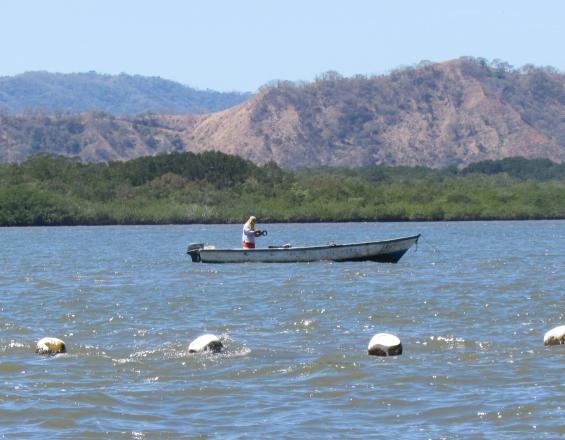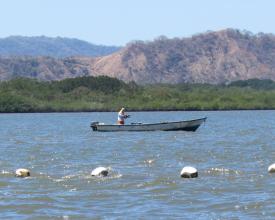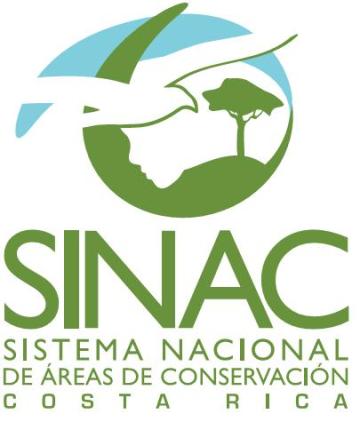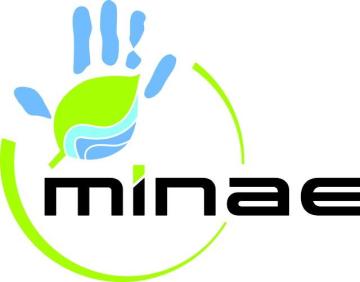
Visión multisectorial de la gestión costera y marina

Esta solución utiliza información científica para priorizar los sitios de importancia para la conservación que son vulnerables al cambio climático en la costa del Pacífico norte de Costa Rica. Un proceso consultivo con participación de residentes, pescadores y autoridades locales y regionales, construye una visión compartida para la gestión sostenible de los recursos costeros y marinos. Las plataformas de diálogo establecen las zonas geográficas, el modelo de gobernanza y las normas de gestión.
Contexto
Défis à relever
- Falta de compromiso de las partes interesadas
- Uso insostenible de los recursos naturales
- Análisis necesarios para identificar las lagunas en los enfoques de conservación biológica existentes y los lugares de importancia para la conservación que son representativos de las zonas críticas
- Las comunidades y los ecosistemas son vulnerables a los efectos del cambio climático
- Mejorar la gobernanza de los entornos costeros y marinos
- Desarrollar procesos participativos que incluyan los intereses de los residentes locales
Ubicación
Procesar
Resumen del proceso
Bloques de construcción
Análisis de la cobertura de las áreas protegidas nacionales
Tres estudios científicos aportan información técnica para identificar las zonas que deben incluirse en el sistema nacional de áreas protegidas. La evaluación de las ecorregiones marinas en Mesoamérica fue el primer paso para lograr una agenda de conservación de la biodiversidad marina y costera a nivel regional. Para cumplir con las metas establecidas para el nivel ecorregional, se identificaron brechas de representatividad e integridad para la biodiversidad marina y costera de Costa Rica a través de una comparación del sistema nacional de áreas marinas protegidas con los sitios de importancia para la conservación identificados durante la evaluación. Los sitios nacionales de importancia para la conservación fueron priorizados en el análisis de brechas. Se realizaron evaluaciones técnicas adicionales para profundizar en el estado de conservación a nivel de los sitios locales. Esta información científica ayudó a elaborar consideraciones sobre las prioridades a nivel local y los usos reales y potenciales junto con los conflictos de uso.
Factores facilitadores
- ONG internacionales y nacionales comprometidas cuentan con asistencia técnica y financiera para desarrollar estos estudios científicos.
- Costa Rica es país signatario de convenios y acuerdos internacionales sobre biodiversidad, comprometiéndose a incrementar las medidas de conservación de los lugares de importancia biológica.
Lección aprendida
Los análisis de carencias para la conservación biológica son un elemento clave para la priorización de lugares importantes para la conservación. La información proporcionada en estos estudios constituye una base de referencia para profundizar en aspectos más específicos y locales. La información científica permite tomar decisiones con conocimiento de causa para aumentar las medidas de conservación.
Evaluación de la vulnerabilidad y los riesgos climáticos
El estudio científico identifica las zonas costeras y marinas de Costa Rica especialmente vulnerables a los impactos del cambio climático. El análisis de vulnerabilidad combinó tres factores: exposición, impactos potenciales y capacidad de adaptación de las comunidades para responder a estos impactos. A través de estos tres factores se evaluaron las amenazas climáticas del aumento del nivel del mar, el aumento de la temperatura atmosférica y los cambios en los patrones de precipitación para identificar la vulnerabilidad. El análisis apoya la priorización de las acciones de adaptación al cambio climático para las áreas protegidas y los distritos de las comunidades locales. Estas acciones incluyen la recuperación de hábitats clave como bosques ribereños, manglares, terrazas de playa y la reubicación de senderos turísticos cerca de la playa dentro de las áreas protegidas.
Factores facilitadores
- Información científica disponible.
- Apoyo técnico y financiero para abordar el proceso
Lección aprendida
La vulnerabilidad al cambio climático varía mucho en la zona estudiada y está estrechamente relacionada con el desarrollo humano y económico. El estudio constató que la aplicación de posibles medidas de adaptación debe empezar por cambios en las pautas de desarrollo y la reducción de las presiones existentes sobre el ecosistema, lo que se conoce como amenazas no climáticas. El estudio también descubrió que las malas prácticas de extracción de recursos y el establecimiento de asentamientos costeros aumentan la sensibilidad de los ecosistemas y la exposición de las comunidades costeras.
Proceso participativo legalmente establecido
Las autoridades locales de conservación elaboraron una resolución administrativa para determinar la viabilidad técnica, social, jurídica y financiera de implantar áreas protegidas en los lugares de importancia para la conservación. La resolución considera la información procedente de estudios científicos y destaca la importancia de establecer un proceso participativo mediante la creación de un panel de diálogo multisectorial. Al mismo tiempo, la autoridad local creó un Comité de seguimiento con representantes institucionales de la autoridad nacional de gestión de áreas protegidas para legitimar el proceso y garantizar su documentación e institucionalización.
Factores facilitadores
- La existencia de un marco jurídico que proporcione directrices
- Apoyo del organismo público responsable de velar por la conservación de la biodiversidad
- Apoyo técnico y financiero
- Compromiso a altos niveles políticos
Lección aprendida
Una resolución jurídicamente vinculante proporciona legitimidad e institucionaliza el proceso, fomenta la capacitación, aumenta la confianza y la credibilidad de las autoridades locales y las comunidades locales.
Plataforma de diálogo multisectorial
Para promover la participación voluntaria y lograr el consenso entre los sectores clave implicados, se identifican las partes interesadas, incluidas las autoridades locales, los pescadores y los residentes locales, entre otros, mediante un mapeo previo de los actores. A continuación, los distintos sectores proponen a sus representantes, que se comprometen formalmente con el proceso mediante la firma de un documento. Se establece una plataforma de diálogo multisectorial y se debaten los intereses de las partes interesadas utilizando un enfoque de facilitación colaborativa y resolución alternativa de conflictos. En esta plataforma se abordan las cuestiones de la delimitación geográfica de la zona de gestión y el modelo de gobernanza con funciones y responsabilidades por sectores y zonas de uso.
Factores facilitadores
- Facilitación del proceso por un mediador neutral y reconocido en la zona.
- Legitimación del proceso mediante la acreditación de representantes institucionales y comunitarios.
- Mapeo de actores como insumo preliminar.
Lección aprendida
La plataforma de diálogo multisectorial promueve la cohesión social entre los sectores. Este espacio permite a los distintos grupos aclarar lo que quieren y no quieren conseguir en el proceso de designación de áreas protegidas. El equipo compuesto por las partes interesadas acreditadas son los líderes del proceso. La nueva dinámica de comunicación creada a través de los diálogos permite que desaparezcan las discordancias del pasado.
Modelo de gobernanza
Los resultados de los diálogos multisectoriales se plasman en acuerdos sobre los planes de aplicación. Estos acuerdos constituyen la base para establecer el modelo de gobernanza, o lo que es lo mismo, el conjunto de normas formales e informales y sus mecanismos de aplicación. Los acuerdos documentan el entendimiento de las partes interesadas sobre la delimitación geográfica del área, su zonificación y la categoría de gestión. También establecen los pasos a seguir en el proceso de implantación de las áreas de gestión, como la consolidación de un modelo de gobernanza a través de un Consejo Local, que es una figura que da soporte legal compuesta por diversos representantes.
Factores facilitadores
- Disponibilidad de los representantes de los equipos negociadores del sector público (SINAC).
- Apoyo técnico y logístico de la cooperación internacional.
- Enfoque de facilitación colaborativa y resolución alternativa de conflictos.
Lección aprendida
El proceso capacita a las partes interesadas mediante su participación en la elaboración de acuerdos. Estos acuerdos son un punto de partida y no de llegada, ya que sientan las bases para la futura cooperación y aplicación. El papel del facilitador y mediador debe ser neutral e independiente, ya que se trata de un papel técnico en la organización del proceso social. Es importante mantener una plataforma única de diálogo, pero con oportunidades para que el facilitador se reúna por separado con cada uno de los sectores. Deben incluirse otros sectores no identificados al inicio de acuerdo con el desarrollo del proceso (por ejemplo, la pesca semi-industrial).
Impactos
- Mejora de las relaciones entre los actores y capacitación de las partes interesadas locales.
- Los distintos grupos han reforzado sus capacidades de negociación, organización y liderazgo.
- Hay una mayor claridad sobre lo que las comunidades locales quieren y no quieren en la gestión de los recursos marinos y costeros.
Beneficiarios
- Comunidades locales que dependen de ecosistemas costeros sanos para su subsistencia
- Sistema Nacional de Áreas de Conservación (SINAC)
- Área de Conservación Tempisque
- Instituto Costarricense de Acuicultura y Pesca (INCOPESCA)
Historia
Mi nombre es Dianney Chacón. Soy pescadora de la comunidad de Cabuya, Península de Nicoya, cerca del Área Protegida Cabo Blanco; he sido pescadora toda mi vida. Mi esposo fue pescador toda su vida. Fui presidenta de la Asociación de Pescadores de mi pueblo y también pertenezco al Grupo de Mujeres de la localidad, sé lo dura que es la vida del pescador cuando no hay para vivir. En mi pueblo la mayoría de las familias viven de la pesca, pero el pescado cada vez escasea más. Cada día nuestros pescadores salen y vuelven con menos pescado y de menor tamaño. Lo mismo pasa con lo que cogen buceando, como la langosta. En nuestro pueblo solo hacemos apnea, pero a diario tenemos que ver como los pescadores de otros lugares vienen a pescar frente a nuestro pueblo, nuestro territorio. Usan compresores y se lo llevan todo, incluso dentro de la zona marina protegida de Cabo Blanco. No podemos hacer nada y las mismas autoridades no responden. A nuestras zonas de pesca también están llegando barcos camaroneros. Al final para los nuestros no queda nada. Los pescadores sabemos que debemos conservar los recursos marinos y queremos crear reglas para pescar. Pero queremos formar parte del proceso para crear estas normas, no que venga alguien de fuera a decirnos lo que tenemos que hacer. Este grupo (plataforma de diálogo) es una oportunidad para nosotros. Podemos pensar, decidir y ponernos de acuerdo con las autoridades locales, con otras organizaciones sociales, empresarios turísticos que también quieren conservar, y así, con la ayuda del gobierno, mejorar la situación de los pescadores. Ha sido difícil para todos los involucrados entender lo que queremos con el proceso, pero logramos llegar a un acuerdo que beneficia a todas las comunidades. Ahora necesitamos más apoyo gubernamental de diferentes instituciones para que nuestra propuesta se haga realidad.


